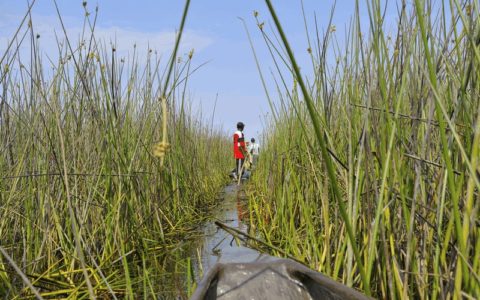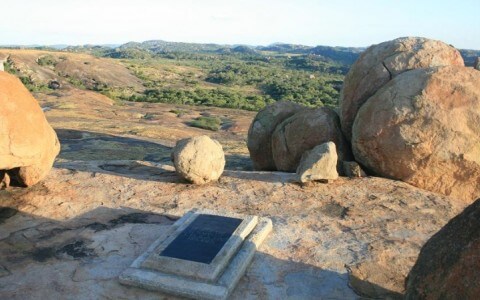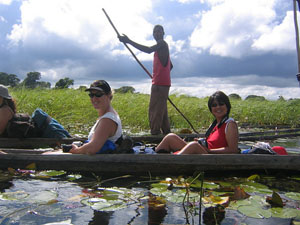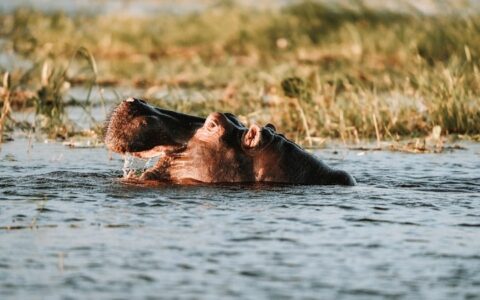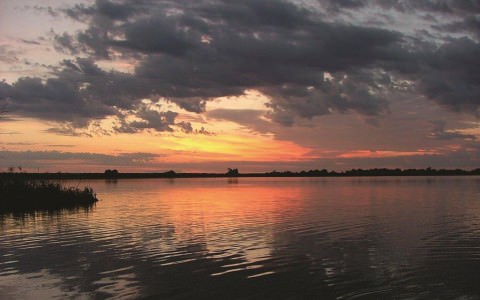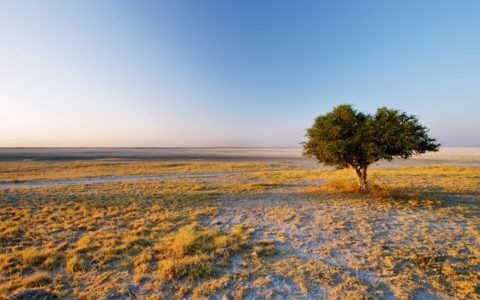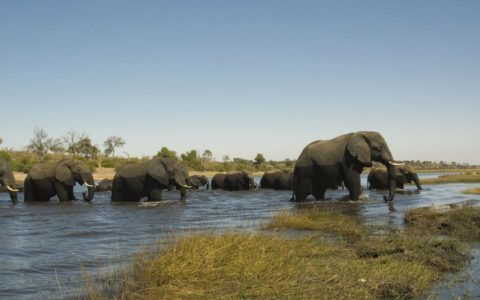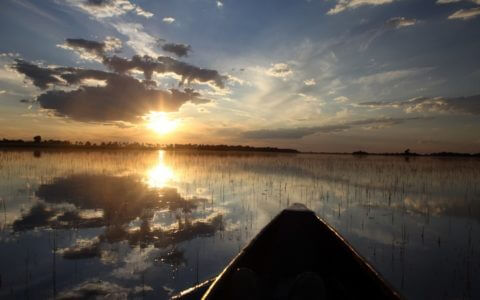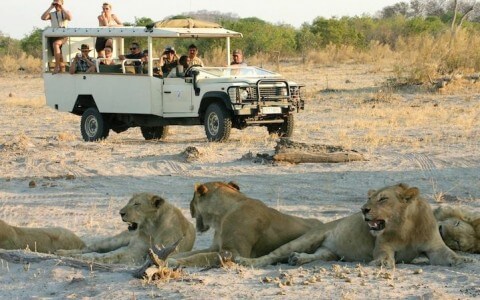Zimbabwe Safari Tours
Zimbabwe is best known as a travel destination for Victoria Falls which is in the North and is within the Victoria Falls National Park. This incredible waterfall of 1 708 meters in width, drops 108 meters straight into the mighty Zambezi River. It certainly earns it’s status as one of the world’s 7 natural wonders.
Zimbabwe borders with Zambia, Mozambique, South Africa and Botswana so some of our tours cover these neighboring countries too. The capital city is Harare with a population of over 12 million people. In Zimbabwe the official language is English however local languages Shona and Ndebele are still widely spoken.
The nightlife of Harare will get your feet moving and your heart pumping. Along with sidewalk cafes, pubs and restaurants expect live music, local delicious cuisine and DJ’s spinning tunes till late. Sports bars are also popular while locals are proud cricket supporters.
Zimbabwe is truly a wildlife seekers dream with a large variety of endemic plants and trees. It is also home to over 350 species of mammals, 500 bird species, 131 fish species and many types of reptiles.
Our Zimbabwe tours visit Hwange National Park which covers 14 650 square kilometers. As a result of the size of the park it is home to over 100 species of mammals and nearly 400 bird species.
Another highlight on this tour is Lake Kariba which is the largest artificial lake in the world. It spans roughly 220 kilometers in length and is 40 kilometers wide. There are also several islands in the lake with plenty of wildlife.
Top Tips for Zimbabwe Travel:
A Travel’s experience of Victoria Falls
Best Time to Overland in Africa: 2019 Travel Calendar
6 Reasons why Victoria Falls should be on your Travel Bucketlist [Guide]
Visiting Zimbabwe: The Top 10 Things to Do
Why go on Zimbabwe Safari Tours?
- * White-water rafting on the mighty Zambezi
- * Sundowners and snacks on a Zambezi Boat Cruise
- * Victoria Falls water sports
- * Afternoon tea at Victoria Falls Hotel
- * African meal in a boma
- * Canoe around Mana Pools
- * Tiger fishing on Lake Kariba
- * Safaris for amazing game viewing
- * Visiting the UNESCO World Heritage Site of the Great Zimbabwe Ruins
While Zimbabwe’s unstable political situation has led to a downturn in tourism, it remains a wonderful country to visit with excellent game parks teeming with wildlife.
Here are a few tips on how to choose your Cape Town To Victoria Falls Overland Tour. Also have a look at the many exciting adventure activities available enroute.
12 Reasons to go on a Zimbabwe Safari Tour
Victoria Falls
The majestic Victoria Falls is a popular yet unique destination as it is the largest waterfall in the world. At a mile long it is a jaw-dropping spectacle which is hailed as one of the Seven Natural Wonders of the World. When David Livingstone first set eyes on the falls, he aptly named it in honor of Queen Elizabeth. Once you’ve seen the falls by walking along the pathway that runs alongside it, get a bird’s eye view from a helicopter ride or microlight flight.
A visit to Victoria Falls would not be complete without a swim in the Devil’s Pool, teetering on the edge of the falls. If that’s not exciting enough, bungee jump off of the 111 meter high Victoria Falls Bridge to the Zambezi River below. Or maybe you would prefer to take a safer view from below and enjoy a houseboat trip downstream while game watching.
Victoria Falls has all the adventure activities you can imagine. Whether you are keen to get wet or would rather stay dry, this trip will ensure you go home with memories of a lifetime.
Game viewing without the crowds
Due to years of political and economic instability, Zimbabwe’s tourist numbers are low compared with its neighbouring countries. Nevertheless, Zimbabwe has excellent game parks and wildlife viewing so it still remains a sought after destination. Safari goers who travel to Zimbabwe’s reserves are rewarded with amazing wildlife without the crowds of Africa’s more famous game parks.
The Hwange National Park
Hwange National Park is Zimbabwe’s largest and busiest. Here game viewing is consistently good all year round due to the many waterholes which attract wildlife morning and night. The Park is in the western region of Zimbabwe, on the main road between Bulawayo and Victoria Falls. Wildlife found here are gemsbok, brown hyena, African wild dogs, giraffe, spotted hyena and cheetahs along with the Big Five.
Hwange Park has one of the world’s largest elephant populations estimated at around 40 000 in total. The seasonal wetland in the park also attracts over 400 bird species. Hwange is best visited during the dry season which is from July to Octobe as this is when the animals are easily spotted congregated around waterholes.
The Mana Pools National Park
For a true wilderness experience, Mana Pools National Park is hard to beat. It is a World Heritage Site due to its natural beauty and abundance of wildlife. The Mana Pools lie in a relatively remote area in the park where you can spot numerous hippos, crocodiles, zebras, elephants, lion, leopards and antelopes.
Zimbabwe is one of the best countries in Africa to do walking safaris in the bush. Walking through wilderness on foot provides a whole new appreciation for the fauna and flora. Mana Pools National Park is the top destination for walking safaris due to it’s sparse vegetation which is ideal for game viewing on foot. However you can also do excellent walking safaris in Matusadona National Park and on concessions in Hwange National Park.
The Great Zimbabwe National Monument
The ruins of the thousand-year-old capital of the Kingdom of Zimbabwe is the country’s greatest archaeological treasure. A UNESCO World Heritage Site with old stone ruins and winding corridors complete with crumbling remains of palaces. Some have called it the greatest medieval city in sub-Saharan Africa. The Zimbabwe Ruins are some of the oldest and largest ruins in Southern Africa with a fascinating history.
Lake Kariba
Lake Kariba is the world’s largest artificial inland lake that attracts huge populations of game.
We recommend spending a couple of days on a houseboat cruising the lake. Maybe go fishing from tender boats for tiger fish and bream. You will also see animals big and small, including Nile crocodiles, elephants and hippopotamus. In addition a wide variety of birdlife such as the African Fish Eagle are amazing to see in action.
Zambezi National Park
Consisting of 40 kilometres of Zambezi River frontage and a combination of wildlife-rich mopane forest and savannah. While Zambezi National Park is well-known for its sable antelope herds, it is also home to giraffe, elephant and lions. Entrance to the Park is just five kilometers northwest of the Victoria Falls town center and is therefore easily accessible by private vehicle. Tour operators on either side of the border offer wildlife drives, guided hikes and fishing trips.
Gonarezhou National Park
This is Zimbabwe’s second largest National Park. It is part of the Great Limpopo National Park which is a transfrontier park that spans Mozambique and South Africa. Gonarezhou is a true wilderness without tarred road or fenced campsites and hence few visitors. However intrepid travelers to Gonarezhou will be rewarded with a high density of elephants along with one of the strongest populations of wild dogs. In addition sightings of lion, hyena and cheetah are possible among 200 meter high cliffs, vast floodplains and mopane woodland.
Matusadona National Park
On the shores of Lake Kariba you will find Matusadona National Park. It is not easily accessible so most safaris arrive by boat or plane. As a result it is beautifully secluded and uncrowded with sightings of the Big Five. Another highlight of this park is that it has one of the largest concentrations of lion in Africa. Look forward to easy sightings of black and white rhino, large herds of buffalo as well as hippo and crocodile.
Matobo National Park
The incredibly scenic Matobo National Park is known for its historical rock art. It’s 3000 sites among towering boulders offer a window into 13 000 years of cultural history.
While you explore the park’s rock art, you’ll also be able to spot its resident wildlife including white rhino, sable antelope, giraffe and zebra. It is also the best place in Zimbabwe to spot leopard as Matobo National Park has the largest concentration of leopard in Africa.
Matobo National Park is located just outside of Bulawayo, and it’s one of Zimbabwe’s smallest and least-known reserves.
Mastobo means “bald heads” in Ndebele, and it’s easy to see why: granite outcrops weathered into balancing boulders are the park’s most stunning feature.
Cecil Rhodes’ grave is among these boulders, as well as 3 000 examples of Khoi rock art and even earlier Stone Age settlements.
Also, it’s a wildlife haven. There are a lot of Verreaux’s (Black) Eagles in Matobo, a place also known for its rhino population.
There’s a 100 km2 (39 sq mi) game park in the national park that’s stocked with animals like white rhinoceros.
If you are looking to get out into the bush on foot, then Matobo National Park is known for its walking safaris and horseback safaris.
When is the best time to visit Matobo National Park?
From May to October, there’s a long dry winter. As the park dries out, animals will concentrate at permanent water sources making it easier to spot wildlife.
Between May and August, you can expect mild sunny days and cool nights, but September and October can be very hot and dry. During the summer rainy season, from November to April, you can expect periodic heavy rain and a lot more mosquitoes.
The Eastern Highlands
The Eastern Highlands are a 300 kilometer mountain range with rugged peaks, dramatic gorges, lush forests and tumbling waterfalls. Nyanga National Park is home to the country’s highest peak – Mount Nyangani. In addition the undeveloped and pristine Chimanimani National Park is a hiker’s paradise. It’s trails lead you through evergreen forests which are home to blue duiker, bushbuck, eland, sable and elusive leopards.
White water rafting and Canoeing
Are you up for paddling the adrenaline pumping Grade 5 rapids of mighty Zambezi River? Feel it’s power as it crashes through a deep gorge and realise why it is hailed as one of the best white water rating experiences in the world. While not for the faint at heart, white water rafting in Zimbabwe is a thrilling adventure you’ll never forget!
Another highlight in Zimbabwe for adventure seekers is a multi-day canoeing trip down the Lower Zambezi. This unique canoe trip along the Mana Pools National Park has the added advantage of wildlife viewing. You’ll see pods of hippos and crocodiles along with herds of elephants, buffalo, lion and amazing birdlife as you paddle along. At night you can camp under a sea of stars on islands or on the river banks.
When is the best time of year for Zimbabwe Safari Tours?
Zimbabwe Dry Season – Winter
Zimbabwe’s Dry season or Winter is during the months of April to October. With almost no rainfall and low humidity along with clear skies and plenty of sunshine.
April and May mark the end of Summer and temperatures cool to about 10°C in the morning and 28°C in the afternoon. The evening brings cooler weather and by May there is there is very little rain.
In June to August the temperatures drop to around 6°C in the mornings. So layer your clothing when getting dressed in the morning because by the afternoon temperatures reach 25°C.
September and October are hotter at 32°C and the rains begin to fall while the humidity increases and can be uncomfortable at times.
During the dry season there is less vegetation due to less rainfall which is ideal conditions for game viewing as animals congregate around waterholes. Less stagnant water also means there are no mosquitoes.
Keep in mind it is also the high season so Victoria Falls could be crowded. The best time to view the falls is from June to September when the spray from the flooding waters doesn’t spoil the view.
Zimbabwe Rainy Season – Summer
Zimbabwe’s Rainy season or Summer is during the months of November to March. This time of year the vegetation is green and lush which is picturesque however game spotting may be harder. Summer is also the time of year when cute baby animals are born which is truly special to watch as the young animals find their way in the wild. Birdwatchers can also delight in the breeding plumage and migratory birds.
Short afternoon showers are possible however they won’t ruin your safari and can in fact be quite refreshing. Keep in mind though that the rain can occur daily and the humidity is very high.
November mornings bring moderate temperatures of 18°C however the mercury can rise to a hot 32°C in the afternoon.
The months of December through to March see the most torrential downpours in the afternoon but sometimes for days on end.
How to get to Zimbabwe
Harare International Airport is the primary airport in Zimbabwe. So if you are flying from Europe you can fly direct with Air Zimbabwe from London or with KLM from Amsterdam. Alternatively fly with South African Airways or Kulula.com via Johannesburg.
South African Airways also offers daily flights direct to the smaller Victoria Falls Airport.
Once you are in Zimbabwe there are numerous domestic flights that will take you to popular destinations within the country.
Facts on Zimbabwe
- Full name: Republic of Zimbabwe
- Capital city: Harare
- Area: 390,580 sq km; 150,803 sq miles
- Population: 13,000,000
- Time Zone: GMT/UTC +2
- Languages: English (official); Shona (other)
- Religion: Syncretic (50%); Christian (25%); indigenous beliefs (24%); Muslim; Other (1%)
- Electricity: 220V; 50HzHz
- Electric Plug Details: British-style plug: 2 flat blades & 1 flat grounding blade or South African/Indian-style plug: 2 circular metal pins above a large circular grounding pin plug configuration
- Country Dialing Code: +263
- Currency: Zimbabwe Dollar (Z$) and USD. Never use credit cards.
- Medical matters: Cholera, Malaria, Rabies, Yellow fever, HIV/AIDS, Schistosomiasis (Bilharzia)



